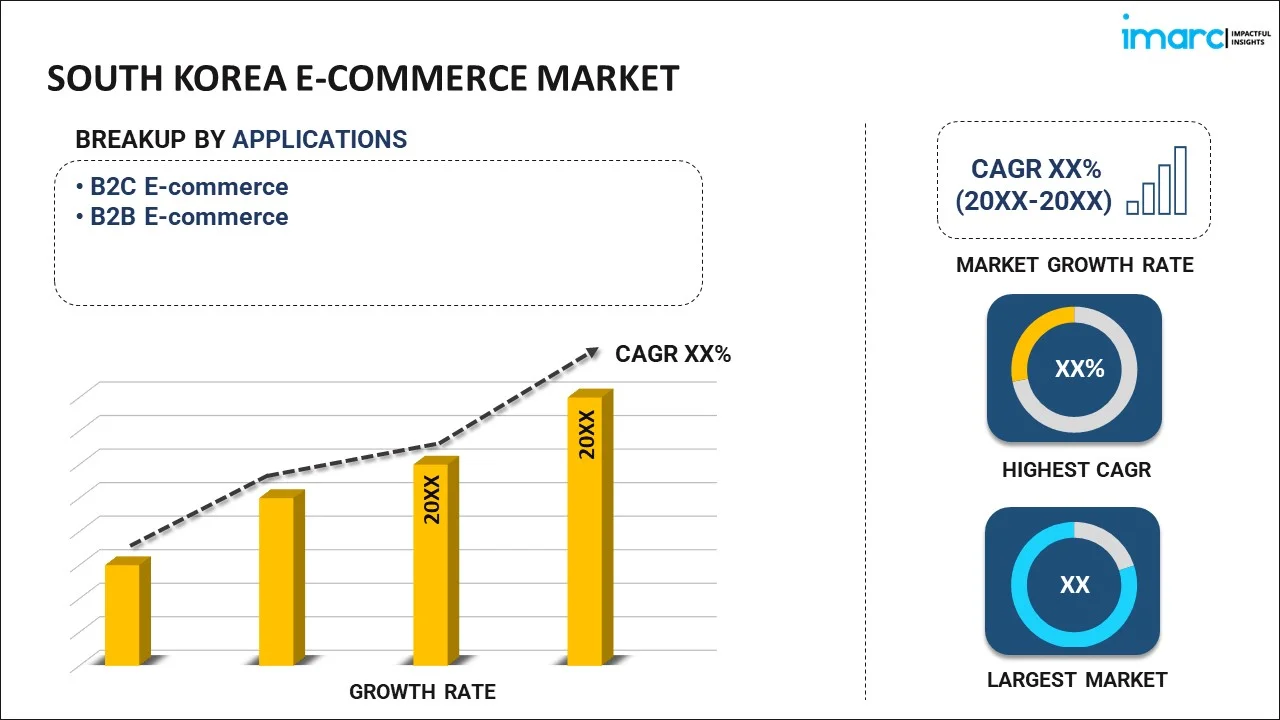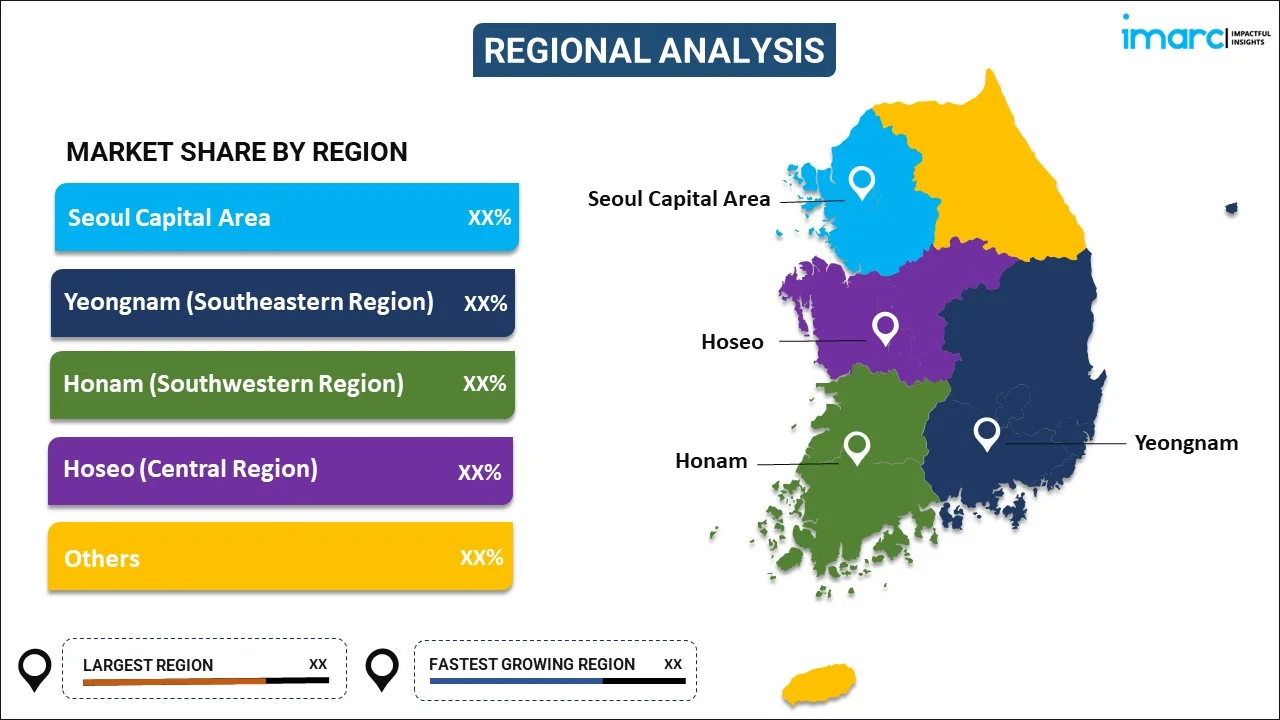
South Korea E-commerce Market Report by Application (B2C E-commerce, B2B E-commerce), and Region 2026-2034
Market Overview:
South Korea e-commerce market size reached USD 623.7 Billion in 2025. Looking forward, IMARC Group expects the market to reach USD 3,881.1 Billion by 2034, exhibiting a growth rate (CAGR) of 22.52% during 2026-2034. The rapid internet penetration, the widespread adoption of mobile commerce, intensifying competition among major players, favorable government initiatives and efficient logistics, the influence of COVID-19, escalating popularity of digital payment systems, and the rise of social commerce are bolstering the market growth.
|
Report Attribute
|
Key Statistics
|
|---|---|
|
Base Year
|
2025
|
|
Forecast Years
|
2026-2034
|
|
Historical Years
|
2020-2025
|
| Market Size in 2025 | USD 623.7 Billion |
| Market Forecast in 2034 | USD 3,881.1 Billion |
| Market Growth Rate 2026-2034 | 22.52% |
Access the full market insights report Request Sample
E-commerce refers to the buying and selling of goods and services through the internet. It has revolutionized the way businesses operate and consumers shop. In this digital era, e-commerce has become an integral part of our daily lives. It operates through online platforms and websites, where businesses showcase their products and services, and consumers browse and make purchases. The process typically involves selecting items, adding them to a virtual shopping cart, providing payment information, and completing the transaction. This convenience and accessibility have made it a preferred choice for consumers worldwide. The uses of e-commerce are multifaceted, such as it caters to various sectors, including retail, finance, entertainment, and more. Consumers can buy anything from clothing and electronics to groceries and digital content, all from the comfort of their homes. Businesses, on the other hand, use e-commerce to expand their reach, reduce overhead costs, and tap into a global market. One of the significant advantages of e-commerce is its 24/7 availability. Unlike physical stores, online shops are open round the clock, allowing customers to shop at their convenience. Additionally, e-commerce offers a vast selection of products, price comparisons, and user reviews, enabling consumers to make informed decisions. Businesses benefit from reduced operational costs, wider market access, and the ability to personalize customer experiences through data analytics.
South Korea E-commerce Market Trends:
The South Korea e-commerce market is influenced by several key drivers, such as the widespread adoption of high-speed internet connectivity and smartphone usage, which has paved the way for a thriving online shopping culture. South Korea boasts one of the highest smartphone penetration rates globally, thereby enabling consumers to shop conveniently on various e-commerce platforms. Moreover, the country's well-developed logistics and infrastructure have streamlined the delivery process, which is driving the market growth. In line with this, the COVID-19 pandemic has accelerated the shift toward online shopping, as consumers sought safer alternatives to in-person retail experiences, which is contributing to the market growth. Additionally, South Korea's tech-savvy population has embraced digital payment methods and mobile wallets, further fueling the market growth. Apart from this, the presence of well-established e-commerce giants, such as Coupang, and the expansion of international players, such as Amazon, have intensified competition, prompting innovation and better customer experiences, which is providing a positive environment for the market across the country.
South Korea E-commerce Market Segmentation:
IMARC Group provides an analysis of the key trends in each segment of the market, along with forecasts at the country level for 2026-2034. Our report has categorized the market based on application.
Application Insights:

To get detailed segment analysis of this market Request Sample
- B2C E-commerce
- Beauty and Personal Care
- Consumer Electronics
- Fashion and Apparel
- Food and Beverage
- Furniture and Home
- Others
- B2B E-commerce
The report has provided a detailed breakup and analysis of the market based on the application. This includes B2C e-commerce (beauty and personal care, consumer electronics, fashion and apparel, food and beverage, furniture and home, and others) and B2B e-commerce.
Regional Insights:

To get detailed regional analysis of this market Request Sample
- Seoul Capital Area
- Yeongnam (Southeastern Region)
- Honam (Southwestern Region)
- Hoseo (Central Region)
- Others
The report has also provided a comprehensive analysis of all the major regional markets, which include Seoul Capital Area, Yeongnam (Southeastern Region), Honam (Southwestern Region), Hoseo (Central Region), and others.
Competitive Landscape:
The market research report has also provided a comprehensive analysis of the competitive landscape in the market. Competitive analysis such as market structure, key player positioning, top winning strategies, competitive dashboard, and company evaluation quadrant has been covered in the report. Also, detailed profiles of all major companies have been provided. Some of the key players include:
- Amazon.com Inc.
- Coupang Corp.
- EMart Inc.
- Interpark Holdings
- Naver Corp
(Please note that this is only a partial list of the key players, and the complete list is provided in the report.)
South Korea E-commerce Market Report Coverage:
| Report Features | Details |
|---|---|
| Base Year of the Analysis | 2025 |
| Historical Period | 2020-2025 |
| Forecast Period | 2026-2034 |
| Units | Billion USD |
| Scope of the Report | Exploration of Historical and Forecast Trends, Industry Catalysts and Challenges, Segment-Wise Historical and Predictive Market Assessment:
|
| Applications Covered |
|
| Regions Covered | Seoul Capital Area, Yeongnam (Southeastern Region), Honam (Southwestern Region), Hoseo (Central Region), Others |
| Companies Covered | Amazon.com Inc., Coupang Corp., EMart Inc., Interpark Holdings, Naver Corp, etc. |
| Customization Scope | 10% Free Customization |
| Post-Sale Analyst Support | 10-12 Weeks |
| Delivery Format | PDF and Excel through Email (We can also provide the editable version of the report in PPT/Word format on special request) |
Key Questions Answered in This Report:
- How has the South Korea e-commerce market performed so far and how will it perform in the coming years?
- What has been the impact of COVID-19 on the South Korea e-commerce market?
- What is the breakup of the South Korea e-commerce market on the basis of application?
- What are the various stages in the value chain of the South Korea e-commerce market?
- What are the key driving factors and challenges in the South Korea e-commerce?
- What is the structure of the South Korea e-commerce market and who are the key players?
- What is the degree of competition in the South Korea e-commerce market?
Key Benefits for Stakeholders:
- IMARC’s industry report offers a comprehensive quantitative analysis of various market segments, historical and current market trends, market forecasts, and dynamics of the South Korea e-commerce market from 2020-2034.
- The research report provides the latest information on the market drivers, challenges, and opportunities in the South Korea e-commerce market.
- Porter's five forces analysis assist stakeholders in assessing the impact of new entrants, competitive rivalry, supplier power, buyer power, and the threat of substitution. It helps stakeholders to analyze the level of competition within the South Korea e-commerce industry and its attractiveness.
- Competitive landscape allows stakeholders to understand their competitive environment and provides an insight into the current positions of key players in the market.
Need more help?
- Speak to our experienced analysts for insights on the current market scenarios.
- Include additional segments and countries to customize the report as per your requirement.
- Gain an unparalleled competitive advantage in your domain by understanding how to utilize the report and positively impacting your operations and revenue.
- For further assistance, please connect with our analysts.
 Request Customization
Request Customization
 Speak to an Analyst
Speak to an Analyst
 Request Brochure
Request Brochure
 Inquire Before Buying
Inquire Before Buying




.webp)




.webp)












